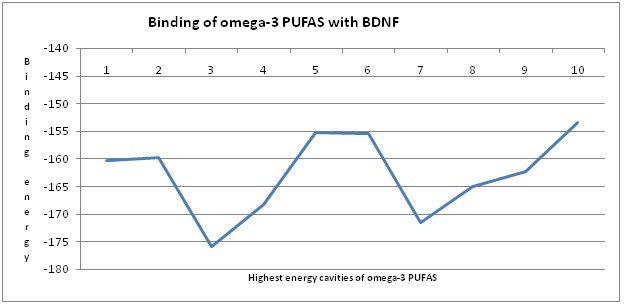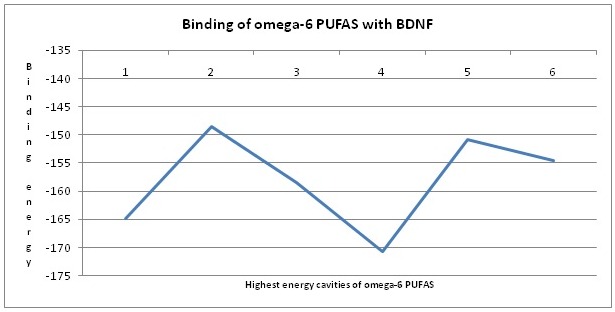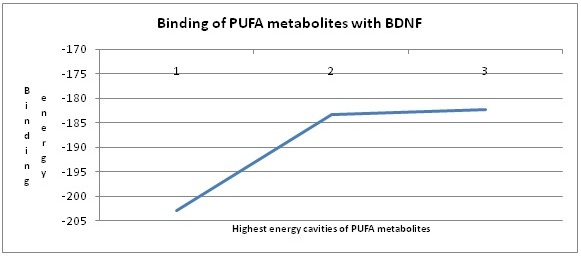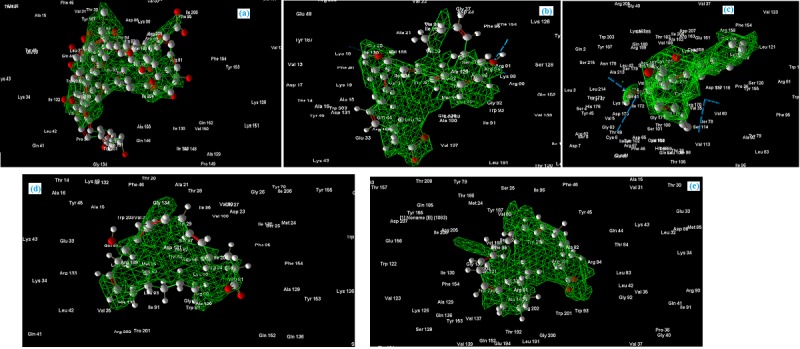Abstract
Brain derived neurotrophic factor (BDNF) is a member of neurotrophic family of growth factors, mainly found in the hippocampus and cerebral cortex of brain. Studies have shown that there is a link between BDNF and cognitive dysfunction, as well as there is a relationship between the PUFAs intake and their effect on BDNF production. Intake of PUFAs, mainly omega-3 and omega-6 has show increase in production of BDNF in brain. In our study we performed docking studies on PUFAs and their metabolites with BDNF using MVD (Molegro Virtual Docker), this has shown that the metabolites of the PUFAs mainly LXA_4, NPD1, HDHA have shown more binding affinity towards BDNF. These metabolites of PUFAs are responsible for modulation of BDNF activity.
Keywords: BDNF, PUFA, Cognitive dysfunction, LXA_4, NPD1, HDHA, MVD, Evolutionary algorithm, cavity detection algorithm, Escore
Background
The glycerophospholipids in the brain contain a high proportion of polyunsaturated fatty acids (PUFAs) derived from essential fatty acids, linoleic acid and alpha-linolenic acid. The main PUFAs in the brain are docosahexaenoic acid (DHA, all cis4,7,10,13,16,19-22:6), derived from omega 3 fatty acid, alpha-linolenic acid, arachidonic acid (AA, all cis5,8,11,14-20:4) and docosatetraenoic acid (all cis7,10,13,16-22:4) are derived from the omega-6 fatty acid. Experimental studies in animals have shown that diet lacking of omega-3 PUFAs lead to substantial disturbances in neural function, which in most circumstances can be restored by the inclusion of omega 3 PUFA in the diet [1]. Pre-clinical and clinical evidence suggests roles for PUFAs in bipolar disorder. omega-3 PUFAs seem to be an effective adjunctive treatment for unipolar and bipolar depression, but further large-scale, well-controlled trials are needed to examine its clinical utility in bipolar disorder [2]. Low levels of BDNF accompany impaired glucose metabolism. Decreased brain-derived neurotrophic factor (BDNF) may be a pathogenetic factor, involved not only in dementia and depression, but also in type 2 diabetes, potentially explaining the clustering of these conditions in epidemiological studies [3]. It is reported that peripheral injection of BDNF exhibits hypophagic and hypoglycemic effects in obese hyperglycemic animals, indicating its anti-obesity and anti-diabetic effects. In the prevention study using 4 week-old db/db mice, treatment with BDNF prevented the age-related increase in blood glucose concentrations. These results showed for the first time that BDNF prevents the development of diabetes in pre-diabetic db/db mice [4]. Brain-derived neurotrophic factor (BDNF) is a potent neurotrophic factor that is implicated in the regulation of food intake and body weight. Polyunsaturated fatty acids (PUFAs) localized in cell membranes have been shown to alter the levels of BDNF in the brain, suggesting that PUFAs and BDNF might interact with each other. To decipher the molecular mechanism through which PUFAs modulates BDNF's activity, molecular docking was performed for BDNF with PUFAs and its metabolites, with 4-Methyl Catechol as control. PUFAs and their metabolites especially, LXA4, modulate insulin resistance by establishing an interaction with BDNF. Similar interaction(s) were noted between BDNF, resolvins and protectins but were of lesser intensity compared to LXA4 [5]. Using molegro virtual docker software, we have proceed further taking omega-3, omega-6 fatty acids and metabolites to study the binding affinity of PUFAs with BDNF. This docking studies will give an idea to the binding affinity of PUFA's which were not discussed previously [5] and the best binding molecule is given importance for further research.
Methodology
Optimization of the BDNF protein structure:
The protein structure of BDNF is optimized by using Chiron [6]. It rapidly minimizes clashes, at the same time causing minimal perturbation of the protein backbone. The resulting structure will have a normalized clash score, that is comparable to high-resolution protein structure (<2.5 Å).
Ligand molecules:
The ligand molecules are obtained from PubChem database which includes ten omega-3 fatty acid, six omega-6 fatty acid structures in the 3D sdf format that can be directly used for the docking studies.
Docking the ligand molecule with BDNF:
Docking of ligand molecules with BDNF was performed by using molegro virtual docker software [7]. This software Binds ligand molecule to BDNF, iteratively evaluate the number of candidate solutions (ligand conformations) and estimates the energy of their interactions with macromolecule. MVD performed a flexible docking by choosing fixed bonds, this flexible docking gave the binding energies of different PUFA's with BDNF and best molecule was evaluated for further research.
The MolDock [8] scoring function improves the scoring functions with a new hydrogen bonding term and new charge schemes. An interactive optimization technique which is inspired by evolutionary algorithms (EA) is used for flexible cavity detection algorithm [9, 10]. The dock scoring function (Escore) is defined by the following energy terms: Escore = Einter +Eintra Where Einter is the ligand-protein interaction energy: Einter = Σ Σ [EPLP(rij)+332.0qiqj/4r2ij] i∈ligand j∈protein
This summation runs over all heavy atoms in ligand and heavy atoms in the protein, including cofactor atoms and water molecule atoms that might present in docking process. The EPLP term is a piecewise linear potential described below. The second term describes the electrostatic interactions between charged atoms.
Eintra is the internal energy of the ligand: (Please see supplementary material)
The double summation is between all atom pairs in the ligand, excluding atom pairs which are connected by two bonds or less. The second term is a torsional energy term, parameterized according to the hybridization types of the bonded atoms, while θ is the torsional angle of the bond. The last term Eclash assigns a penalty of 1000 if the distance between two heavy atoms (More than two bonds apart) is less than 2.0 A. This Eclash term punishes non-feasible ligand conformations.
Generation of cavities for binding:
Cavities were generated in order to narrow down the potential binding site of a protein. After generating the cavity, docking was done with the PUFA's on BDNF receptor molecule.
Generation of poses in the cavity:
Cavity identifies five poses which were found by search algorithm. This option greatly reduces the overall docking process and increases the accuracy of the docking procedure. All poses in the runs were clustered, and similar poses were removed to find the best-scoring pose.
Docking procedure for omega-3, omega-6 PUFA's and their metabolites with BDNF:
We took the structures of ten omega-3 PUFAs, six structures of the omega-6 PUFAs and three metabolites LXA_4, NPD1, HDHA which ware docked against the BDNF protein structure. The results are tabulated according to the highest energy cavity of each PUFA and metabolite (Figure 1, Figure 2, Figure 3).
Figure 1.

Binding energies of omega-3 fatty acids with BDNF.
Figure 2.

Binding energies of omega-6 fatty acids with BDNF.
Figure 3.

Binding energies of metabolites of PUFAS with BDNF.
Results & Discussion
We can disclose that Table no.1 confirms 12-Hydroxy-5,8,10,14- eicosatetraenoic acid(5312983) have high dock score than the remaining other omega-3 PUFA molecules, Table no.2 has evidence that docosa-4,7,10,13,16-pentaenoic acid(5282848) have high dock score than remaining omega-6 PUFAs molecules and from the Table.3 we can substantiate that metabolites like LXA_4 (5280914) have high dock score than omega-3, omega-6 PUFAs. Figure no 4 frame up the interaction of BDNF molecule with best metabolites (LXA_4), omega-3 and omega-6 molecules.
Figure 4.

a) BDNF-LXA_4; b) BDNF-NPD1; c) BDNF-HDHA; d) BDNF-12-Hydroxy-5,8,10,14-eicosatetraenoic acid(omega-3 PUFA); e) BDNF- docosa-4,7,10,13,16- pentaenoic acid(omega-6 PUFA).
Conclusion
From the results we conclude that the metabolites of PUFAs (LXA_4, NPD1, HDHA) have higher binding affinity towards BDNF, than the PUFAs in the original form like omega-3 and omega-6. This suggests that metabolites of PUFAs may bind to BDNF in order to increase its activity in cognitive functioning, there by mitigating the type-2 diabetes. LXA_4 have shown high affinity towards binding to BDNF, when compared to omega-3 and omega-6 PUFAs. Hence in-silico method proves that metabolites of PUFAs are showing more binding affinity. Therefore more extensive wet lab research is needed to support our results.
Supplementary material
Acknowledgments
Authors would like to thank Department of Science and Technology, Government of India.
Footnotes
Citation:Kumar et al, Bioinformation 9(18): 908-911 (2013)
References
- 1.Sinclair AJ, et al. Asia Pac J Clin Nutr. 2012;16:S391. [Google Scholar]
- 2.Balanzá-Martínez V, et al. Expert Rev Neurother. 2011;11:1029. doi: 10.1586/ern.11.42. [DOI] [PubMed] [Google Scholar]
- 3.Krabbe KS, et al. Diabetologia. 2007;50:431. doi: 10.1007/s00125-006-0537-4. [DOI] [PubMed] [Google Scholar]
- 4.Yamanaka M, et al. Biomedical Research. 2008;29:147. doi: 10.2220/biomedres.29.147. [DOI] [PubMed] [Google Scholar]
- 5.Vetrivel U, et al. Lipids Health Dis. 2012;11:109. doi: 10.1186/1476-511X-11-109. [DOI] [PMC free article] [PubMed] [Google Scholar]
- 6.Ramachandran S, et al. Proteins. 2011;79:261. doi: 10.1002/prot.22879. [DOI] [PMC free article] [PubMed] [Google Scholar]
- 7. http://www.molegro.com/mvd-product.php.
- 8.Thomsen R, et al. J Medicinal Chem. 2006;49:3315. doi: 10.1021/jm051197e. [DOI] [PubMed] [Google Scholar]
- 9.Jones G, et al. J Molecular Biology. 1997;267:727. doi: 10.1006/jmbi.1996.0897. [DOI] [PubMed] [Google Scholar]
- 10.Wei BQ, et al. J Mol Biol. 2004;337:1161. doi: 10.1016/j.jmb.2004.02.015. [DOI] [PubMed] [Google Scholar]
Associated Data
This section collects any data citations, data availability statements, or supplementary materials included in this article.


